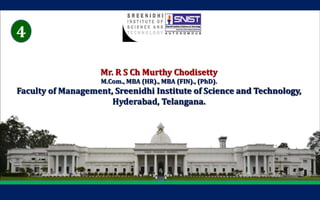
Lecture 4
- 1. 1 Mr. R S Ch Murthy Chodisetty M.Com., MBA (HR)., MBA (FIN)., (PhD). Faculty of Management, Sreenidhi Institute of Science and Technology, Hyderabad, Telangana. 4
- 2. 2 FUNDAMENTAL OF FINANCIAL ACCOUNTING LECTURE-4
- 3. 3
- 4. 4
- 5. 5 ACCOUNTING : Accounting or accountancy is the measurement, processing, and communication of financial information about economic entities such as businesses and corporations. The modern field was established by the Italian mathematician Luca Pacioli in 1494
- 6. 6 NEED FOR ACCOUNTING: ® As you are aware, every trader generally starts business for purpose of earning profit. ® While establishing business, he brings own capital, Then he purchases machinery, furniture, raw materials and other assets. ® He starts buying and selling of goods, paying for salaries, rent and other expenses, depositing and withdrawing cash from bank. Like this he undertakes innumerable transactions in business.
- 7. 7 DEFINITION OF ACCOUNTANCY: ® Accountancy is the science of RECORDING and CLASSIFYING business transactions and events, primarily of financial character and the art of making significant SUMMARIES, ANALYSIS & INTERPRETATIONS of those transactions and events, & COMMUNICATING the results to persons who make decisions or form judgments”
- 8. 8 USERS OF ACCOUNTING INFORMATION: The users of accounting can be divided in two board groups (1). Internal users and (2). External users. Internal users External users Managers Researchers Investors Government Workers Creditors
- 9. 9 OBJECTIVES OF ACCOUNTANCY: ® To keep permanent, accurate and complete record of business transactions ® To maintain records of incomes and expenses and losses in such a way that, the Net profit/Loss for any specified period is ascertained ® To maintain records of Assets and Liabilities and in such a way that, the Financial position of the business at any point is ascertained ® To provide information for legal & tax purposes.
- 10. 10 ACCOUNTING PRINCIPLES: ® Accounting principles are general rules adopted in accounting ® These principles enables standardization in recording & reporting of financial information ® Accounting principles may be defined as those rules of conduct or procedures which are adopted by the accountants universally while recording the accounting transactions.
- 11. 11 ACCOUNTING PRINCIPLES: Accounting principles are classified in to two categories 1.Accounting concepts 2.Accounting conventions
- 12. 12 ACCOUNTING CONCEPTS: • Business entity concept • Dual aspect concept • Going concern concept • Cost concept • Money measurement concept • Accounting period concept • Matching concept • Realization concept Accounting concepts means conditions or assumptions upon which accounting is based.
- 13. 13 ACCOUNTING CONVENTIONS: • Convention of Consistency • Convention of Disclosure • Convention of Materiality • Convention of Conservatism Accounting conventions refers to Customs or Traditions followed by accountants as a Guide in preparation of financial statements .
- 14. 14 DOUBLE ENTRY SYSTEM: The term double-entry accounting refers to the rules by which transactions and events are recorded. Double-entry accounting specifies that for every entry appearing on the left side (debit) of an account, there needs to be a corresponding entry on the right hand side (credit) of an account.
- 16. 16 ACCOUNTING STANDARDS : Accounting standards are authoritative standards for financial reporting and are the primary source of generally accepted accounting principles (GAAP). ... In Canada, accounting standards for all entities outside the public sector are issued by the Accounting Standards Board.
- 18. 18 JOURNAL ENTRY : A journal entry, into accounting, is the logging of a transaction in accounting journal items. The journal entry can consist of several recordings, each of which is either a debit or a credit. The total of the debits must equal the total of the credits or the journal entry is said to be "unbalanced".
- 19. 19 LEDGER: A ledger is the principal book or computer file for recording and totaling economic transactions measured in terms of a monetary unit of account by account type, with debits and credits in separate columns and a beginning monetary balance and ending monetary balance for each account.
- 20. 20 LEDGER: A ledger is the principal book or computer file for recording and totaling economic transactions measured in terms of a monetary unit of account by account type, with debits and credits in separate columns and a beginning monetary balance and ending monetary balance for each account.
- 21. 21 TYPES OF LEDGERS: ® Debtors Ledger ® Creditors Ledger ® General Ledger ® Self Ledger
- 22. 22 JOURNAL: In accounting and bookkeeping, a journal is a record of financial transactions in order by date. A journal is often defined as the book of original entry. The definition was more appropriate when transactions were written in a journal prior to manually posting them to the accounts in the general ledger or subsidiary ledger. Manual systems usually had a variety of journals such as a sales journal, purchases journal, cash receipts journal, cash disbursements journal, and a general journal.
- 24. 24 SUBSIDIARY BOOKS: ® Cash Book. ® Purchase Book. ® Purchase Return Book. ® Sales Book. ® Sales Return Book. ® Bills Receivable Book. ® Bills Payable Book. ® Journal Proper.
